I see in your screenshots that you already have a Balkans Front - a little bit of hubris, perchance? 
The Great Patriotic War
- Thread starter loki100
- Start date
-
We have updated our Community Code of Conduct. Please read through the new rules for the forum that are an integral part of Paradox Interactive’s User Agreement.
You are using an out of date browser. It may not display this or other websites correctly.
You should upgrade or use an alternative browser.
You should upgrade or use an alternative browser.
What you're seeing at the moment is the result of that block of supplies I gave them in June. They've now shifted IC to replacements but obv in doing so are draining their manpower. They have 720 at the start of August and just under 100 by the start of Sept. The result is all those weak formations I've been bullying in June-July are all of a sudden a lot tougher, but of course they are then reliant on their monthly recruitment to keep their divisions up to strength.
Ah, right. I do now remember you having said that about the AI frantically trying to produce supplies to the exclusion of everything else. So it's not currently a case of the Germans being on their last legs (which does seem a bit early in 1942), but having dropped their manpower to the extent you have it suggests that 1943 will be a different story. I wouldn't want to be a recently drafted German soldier when next year's counterattack gets up to speed.
The economic model is a huge simplification, esp for the Soviet Union. They tended to group similar factories together in regional centres and shift stuff somewhere else to finish. For example about 50% of their tank steel came from the factories at Cherepovets and was then shifted off to the Urals to build the T-34s. Also the IC around Moscow and Leningrad was essential to knit together all the rest.
Yes you are right that IC works regardless of physical link to resources. So my isolated IC at Leningrad is still gleefully pumping out fuel etc.
Sorting out both & adding discrete rails would really start to give certain locations a real strategic value.
It would also make strategic bombing a lot more important, with the proviso that you'd have to make factories a lot more difficult to hit, or a lot quicker to repair, or both. Similarly, you could task bombers to attack rail junctions and bridges. Of course, designing an AI that can deal with the added complexity in a sensible way is part of the challenge - at the moment I tend to the think of it as a competent but pedestrian staff officer, capable of building and maintaining a front and probing for weaknesses, but out of its depth when asked do something more complex than a broad-fronted advance.
How much of a difference do you find a skill 5 commander makes to the units under their control? In my current game as Italy I managed to muddle along with whatever leaders I had, but did feel that I was missing a trick.
I think it says something about the amount of effort that the Germans are putting in to breaking Eight Army that Chuikov has three times as much experience accumulated as any other general on that Front. Keep holding them, Vasily Ivanovich. You'll be a Marshal yet. Although I doubt if they'll bury you on Mamayev Kurgan.
Very good updates. Excellent stuff having pocketed quite a number of Axis troops in the Artic theatre, long may the successes continue. The introduction of guard divisions/units seems useful and it is good to see that promotions are now being made based upon merit rather than for non-military reasons (rather seems an oddity for a communist army!). Everything seems to be going rather well.
I see in your screenshots that you already have a Balkans Front - a little bit of hubris, perchance?
there was a lot of hubris at this stage -- we'll come to my Syrian (mis)adventures at some stage soon
Ah, right. I do now remember you having said that about the AI frantically trying to produce supplies to the exclusion of everything else. So it's not currently a case of the Germans being on their last legs (which does seem a bit early in 1942), but having dropped their manpower to the extent you have it suggests that 1943 will be a different story. I wouldn't want to be a recently drafted German soldier when next year's counterattack gets up to speed.
It would also make strategic bombing a lot more important, with the proviso that you'd have to make factories a lot more difficult to hit, or a lot quicker to repair, or both. Similarly, you could task bombers to attack rail junctions and bridges. Of course, designing an AI that can deal with the added complexity in a sensible way is part of the challenge - at the moment I tend to the think of it as a competent but pedestrian staff officer, capable of building and maintaining a front and probing for weaknesses, but out of its depth when asked do something more complex than a broad-fronted advance.
How much of a difference do you find a skill 5 commander makes to the units under their control? In my current game as Italy I managed to muddle along with whatever leaders I had, but did feel that I was missing a trick.
Its not till late in 43 do I start to notice German units shattering again so my guess is they repaired all the losses and limp along fairly well on their monthly reinforcements for quite a while. But they do stop any new builds so as I slowly cull out their OOB, then the Wehrmacht gets steadily smaller, but its not till post-Berlin can it not really maintain a continuous front.
I think Slan with the HPP project is doing some tweaks to the industrial modela that look interesting. More generally what would really help is to help the AI with priorities (using the victory conditions?). So at the moment OKH has a pretty sensible range of objectives in the USSR but no prioritisation. So as Archangelsk was relatively undefended it went for that not Moscow or the Ukraine. Some weighted algorithm to its decision making would be great - esp in this sort of case where the real, big-ticket, prizes are so clear - take Leningrad, Moscow and Kharkov and its pretty hard for the USSR to survive.
When I promoted a load of 5-6 commanders to the Armies I did notice a real change in performance. It boosted org quite nicely and that in turn boosted org regain (ie due to how morale affects recovery). Combined with the similar gains for the Gds designation and by early/mid-43 I had quite a few divisions easily as good as their German opponents in terms of equipment and organisation - once you do that only the RKKA is going to emerge the winner. The only advantage the German's really had left was a higher incidence of favourable battle events - but I was getting a lot of 'assault' events as well.
Not enough logistic wizards. Put them everywhere at the top of the OOB.
Despite my current mutterings about supply it wasn't that big an issue at this stage. Its more delivery than its existence, so my preference was to emphasise organisation gain over the improvement in supply delivery. Over in C/Asia and later the Far East, then yes, anything that eases supply was very attractive.
I think it says something about the amount of effort that the Germans are putting in to breaking Eight Army that Chuikov has three times as much experience accumulated as any other general on that Front. Keep holding them, Vasily Ivanovich. You'll be a Marshal yet. Although I doubt if they'll bury you on Mamayev Kurgan.
I've not really covered that fighting in much detail as its all the loss/gain of the same spread of provinces, but the Germans really don't like my 8 Army, which is well shown by his exp gain. Also up to Feb 42 he was a corps commander so that may have helped a bit.
In this game, my guess is that Vasily Ivanovich deserves a place of honour at Kalinin, he certainly spends a lot of time defending the approaches to it.
Very good updates. Excellent stuff having pocketed quite a number of Axis troops in the Artic theatre, long may the successes continue. The introduction of guard divisions/units seems useful and it is good to see that promotions are now being made based upon merit rather than for non-military reasons (rather seems an oddity for a communist army!). Everything seems to be going rather well.
I'll pass on the opportunity to discuss the pre-war promotion system in the RKKA. But in-game, those Gds divs become increasingly useful as the related tech improves. By early 44, I've got 50+, and they are my main shock units (outside the armour).
Impressive stuff as ever.
If I were the Germans I would be sending a lot of peace envoys at this point.
If I were the Germans I would be sending a lot of peace envoys at this point.
Impressive stuff as ever.
If I were the Germans I would be sending a lot of peace envoys at this point.
as in the next post, I slowly start to exact revenge for my losses at Archangelsk. In game, this was a period when I still thought a long drawn out stalemate was possible, but certainly no longer could imagine actually losing.
"Let Go. Then. Overcome" – The Arctic Battles July-August 1942
The Arctic battles of July and August saw mixed outcomes. The worst was the shameful surrender at Murmansk, but on the other hand the junction between the forces of the Leningrad Front and the bulk of the Western Strategic direction, combined with 1 and 2 Army sustaining their offensives, pointed to an eventual Soviet liberation of the entire sector.
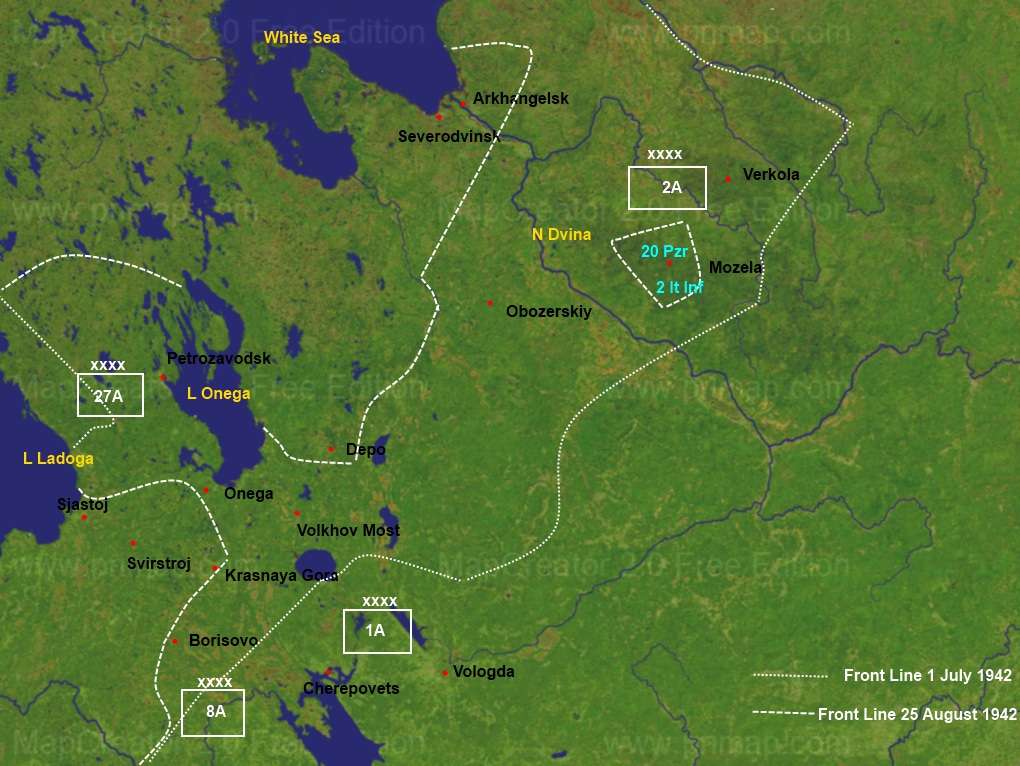
Murmansk had been precariously held since late 1941 and cut off from resupply once Archangelsk fell in May 1942. The only thing that protected it was the VVS' commitment to raiding the axis supply lines. By July, the mounting fighting at Leningrad and the need to support the drive of 27 Army to link up with the main Soviet forces meant the Pe-2s were diverted from these duties. The end was quick once the Axis forces attacked and 37, 577 Soviet troops surrendered on 20 August 1942.
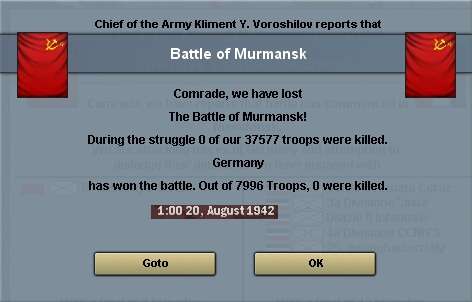
This disaster came at a period when the entire Summer offensive was faltering but had little effect on wider Soviet morale. It was presented in the press and in party briefings as the work of traitors and the contrast between this and the heroic defense of Archangelsk meant this explanation was widely accepted.
Strangely, the subsequent destruction of the remnants of the Arctic Fleet did have wider ramifications. The Soviet press had built up an image of the heroism of the RKKH, in particularly in the Black Sea and of the submarine arm. This made the news of the disaster off Archangelsk all the more shocking.

In the meantime, 27 Army operating between Lakes Ladoga and Onega was making steady progress. 7 Corps took Petrozavodsk (to threaten the rear of the axis forces attacking Murmansk) and managed to beat off a German counterattack on 30 July, but at this stage both sides were exhausted and went over to the defence in the region north of Lake Onega.
The other two corps (19 and 29) made steady progress southwards, both clearing axis forces from the west shore of Lake Onega and breaking out southwards. By 3 August, it joined with elements of 8 Army in clearing Borisovo Sudskoye, creating the first land connection between Leningrad and Moscow since December 1941.
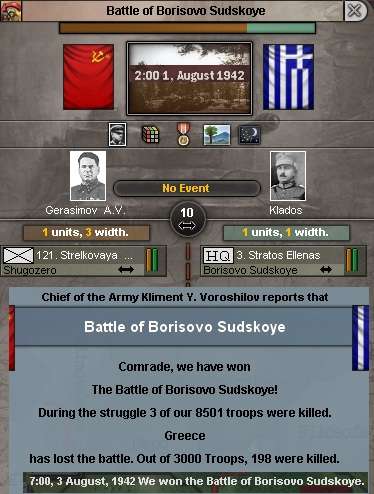
(by any measure of the time, Borisovo Sudskoye would scarcely have been recorded in the STAVKA records except for the iconic reconnection of Moscow and Leningrad)
At this stage, the army had to fend off the full force of a German counterattack. Svirstroj and Sjastroj were lost on 15 August. Critically the first German attempt to retake Krasnaya Gora was beaten off on 14 August and this delay allowed 1 Army to beat back the attempt of the Arctic group of German forces to break out westwards.
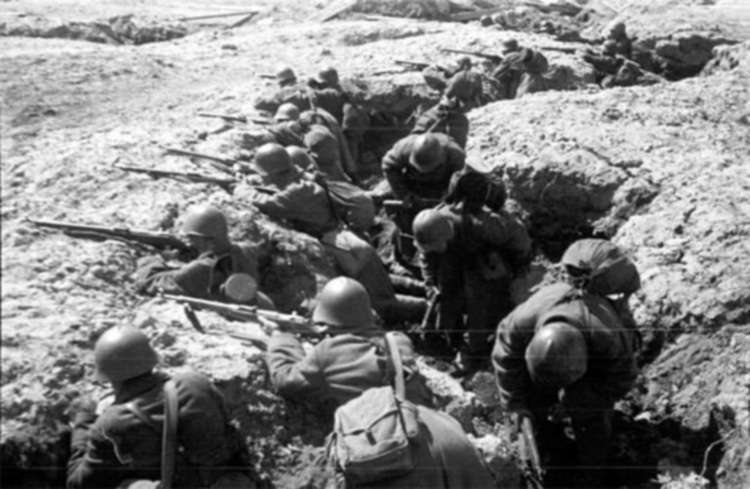
(hasty Soviet defense lines at Krasnaya Gora)
By the time the Germans took Krasnaya Gora on 24 August and Olonec on 25 August, the German forces in the arctic were pulling back eastwards. Although the German Army Group North was to break the remaining connection between Leningrad and Moscow, OKH, by ordering the Arctic forces not to break out to the west had doomed them to ultimate destruction.
In the Arctic proper, 1 and 2 Armies made slow but steady progress northwards. Once the Axis forces were cut off they became reliant on Archangelsk for their supply needs. In summer this was feasible and STAVKA realised that the Pe-2s at Vologda lacked the range to attack their shipping. In consequence, the decision was made to bomb Archangelsk with the goal of destroying the port and transport infrastructure. All August, Soviet bombers destroyed their own city.
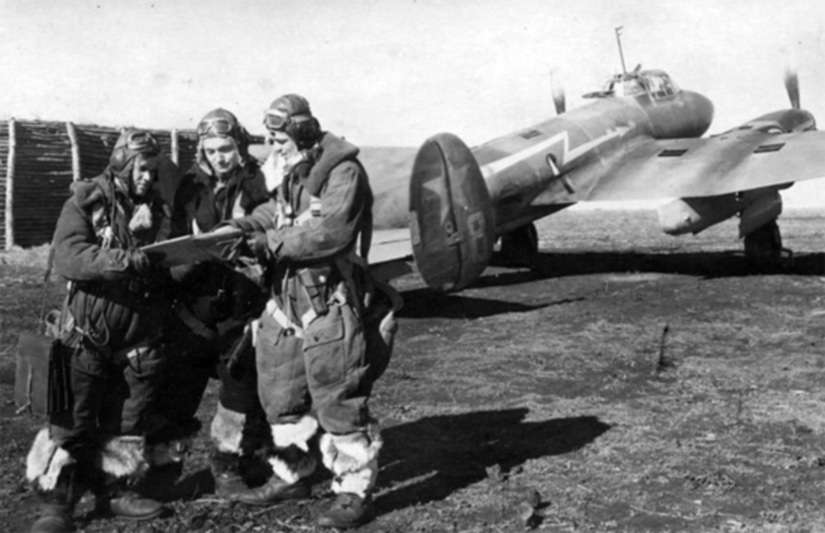
(Pe-2s at Vologda preparing to destroy Archangelsk)
1 Army stopped the attempted breakout at Volkhov Minsk on 18 August although a follow up attack at Depo was beaten off on the 26th.
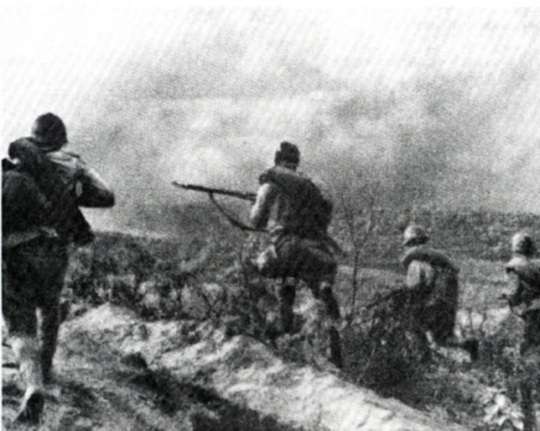
(elements of 1 Army attacking the Axis forces near Volkhov Minsk)
At this stage the front started to break up and German units fell into encirclement. The pocket at Obozerskiy was overun on 21 August increasing the depth of the Soviet ring seperating the Arctic forces from their would be liberators.

Further east, 20 Panzer at Mozela delayed its fate by beating off the first Soviet attacks on 22 August.
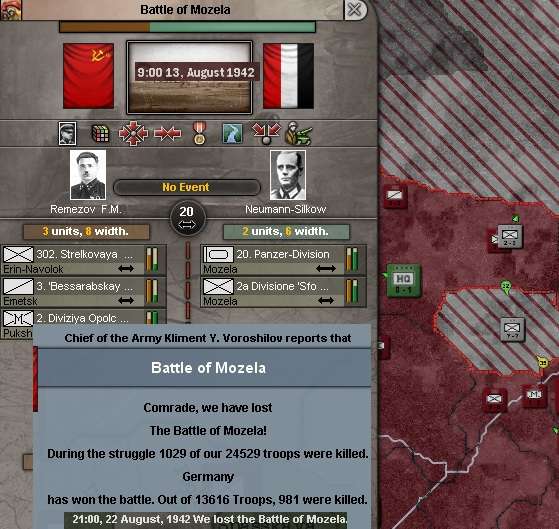

(destroyed German tank at Mozela, the remaing armour was out of fuel and only of use as fixed defense posts - the Soviets were prepared to wait before moving in for their final destruction)
In the meantime Soviet troops pushed steadily northwards through the Urals to the east of Archangelsk, especially after the last German attack in this sector was defeated at Verkola on 22 August.
At this stage 3 largely seperate battles started. Those in the Urals were characterised by the slow reduction of German pockets and skirmishes between Soviet cavalry and Axis forces retreating to Archangelsk.
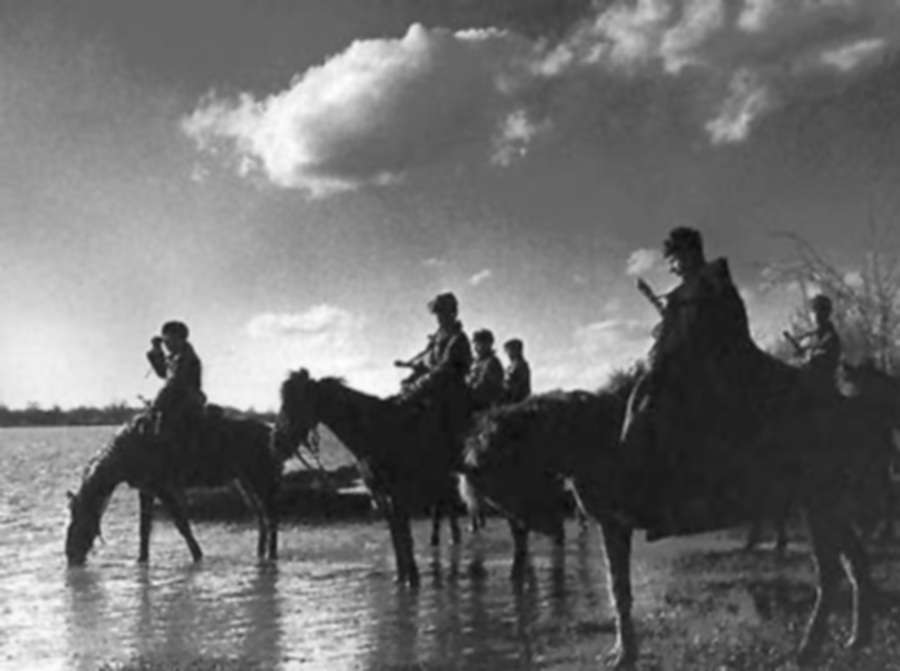
(Soviet cavalry take a break near the North Dvina, their mobility was critical in this region)
The Germans managed to reconstruct a coherent front in the Archangelsk region and for the moment stall the Soviet attack. Finally a large number of axis units were trapped between Lake Onega and the White Sea. At the end of August these were a potential threat and could have possibly broken out westwards. However, once 7 Corps was in a position to exploit its position at Petrozavodsk, they were at threat from encirclement and being cut off from retreat north to Murmansk or east to Archangelsk.
The losses in this sector are easily obscured by the horrendous casualty rates of Suvorov and the subsequent German counterattack. However, in the Ladoga fighting 18,473 Soviet and 24,202 Axis soldiers lost their lives (only one-third of these were German) and in the rest of the sector 17,925 Soviet and 19,481 Axis soldiers were killed. In addition, 37,577 Soviet soldiers surrendered at Murmansk and 19,361 Germans had surrendered at Obozerskiy. The Germans were slowly being presented with the bill for their over-confidence when they pushed into this region in November 1941.
However, STAVKA was growing increasingly concerned that as 1 Army was being pushed back eastwards, and 23 Army back into the region between Lakes Ladoga and Onega, it was critical that the Axis forces around Archangelsk were destroyed quickly. Not for the first time the gap between STAVKA's directives, and what could be achieved, led to needless losses as Soviet forces failed to wait for reserves to move up. Equally, even in late August, in this region, the first signs of winter were being felt.
The Arctic battles of July and August saw mixed outcomes. The worst was the shameful surrender at Murmansk, but on the other hand the junction between the forces of the Leningrad Front and the bulk of the Western Strategic direction, combined with 1 and 2 Army sustaining their offensives, pointed to an eventual Soviet liberation of the entire sector.

Murmansk had been precariously held since late 1941 and cut off from resupply once Archangelsk fell in May 1942. The only thing that protected it was the VVS' commitment to raiding the axis supply lines. By July, the mounting fighting at Leningrad and the need to support the drive of 27 Army to link up with the main Soviet forces meant the Pe-2s were diverted from these duties. The end was quick once the Axis forces attacked and 37, 577 Soviet troops surrendered on 20 August 1942.

This disaster came at a period when the entire Summer offensive was faltering but had little effect on wider Soviet morale. It was presented in the press and in party briefings as the work of traitors and the contrast between this and the heroic defense of Archangelsk meant this explanation was widely accepted.
Strangely, the subsequent destruction of the remnants of the Arctic Fleet did have wider ramifications. The Soviet press had built up an image of the heroism of the RKKH, in particularly in the Black Sea and of the submarine arm. This made the news of the disaster off Archangelsk all the more shocking.

In the meantime, 27 Army operating between Lakes Ladoga and Onega was making steady progress. 7 Corps took Petrozavodsk (to threaten the rear of the axis forces attacking Murmansk) and managed to beat off a German counterattack on 30 July, but at this stage both sides were exhausted and went over to the defence in the region north of Lake Onega.
The other two corps (19 and 29) made steady progress southwards, both clearing axis forces from the west shore of Lake Onega and breaking out southwards. By 3 August, it joined with elements of 8 Army in clearing Borisovo Sudskoye, creating the first land connection between Leningrad and Moscow since December 1941.

(by any measure of the time, Borisovo Sudskoye would scarcely have been recorded in the STAVKA records except for the iconic reconnection of Moscow and Leningrad)
At this stage, the army had to fend off the full force of a German counterattack. Svirstroj and Sjastroj were lost on 15 August. Critically the first German attempt to retake Krasnaya Gora was beaten off on 14 August and this delay allowed 1 Army to beat back the attempt of the Arctic group of German forces to break out westwards.

(hasty Soviet defense lines at Krasnaya Gora)
By the time the Germans took Krasnaya Gora on 24 August and Olonec on 25 August, the German forces in the arctic were pulling back eastwards. Although the German Army Group North was to break the remaining connection between Leningrad and Moscow, OKH, by ordering the Arctic forces not to break out to the west had doomed them to ultimate destruction.
In the Arctic proper, 1 and 2 Armies made slow but steady progress northwards. Once the Axis forces were cut off they became reliant on Archangelsk for their supply needs. In summer this was feasible and STAVKA realised that the Pe-2s at Vologda lacked the range to attack their shipping. In consequence, the decision was made to bomb Archangelsk with the goal of destroying the port and transport infrastructure. All August, Soviet bombers destroyed their own city.

(Pe-2s at Vologda preparing to destroy Archangelsk)
1 Army stopped the attempted breakout at Volkhov Minsk on 18 August although a follow up attack at Depo was beaten off on the 26th.

(elements of 1 Army attacking the Axis forces near Volkhov Minsk)
At this stage the front started to break up and German units fell into encirclement. The pocket at Obozerskiy was overun on 21 August increasing the depth of the Soviet ring seperating the Arctic forces from their would be liberators.

Further east, 20 Panzer at Mozela delayed its fate by beating off the first Soviet attacks on 22 August.


(destroyed German tank at Mozela, the remaing armour was out of fuel and only of use as fixed defense posts - the Soviets were prepared to wait before moving in for their final destruction)
In the meantime Soviet troops pushed steadily northwards through the Urals to the east of Archangelsk, especially after the last German attack in this sector was defeated at Verkola on 22 August.
At this stage 3 largely seperate battles started. Those in the Urals were characterised by the slow reduction of German pockets and skirmishes between Soviet cavalry and Axis forces retreating to Archangelsk.

(Soviet cavalry take a break near the North Dvina, their mobility was critical in this region)
The Germans managed to reconstruct a coherent front in the Archangelsk region and for the moment stall the Soviet attack. Finally a large number of axis units were trapped between Lake Onega and the White Sea. At the end of August these were a potential threat and could have possibly broken out westwards. However, once 7 Corps was in a position to exploit its position at Petrozavodsk, they were at threat from encirclement and being cut off from retreat north to Murmansk or east to Archangelsk.
The losses in this sector are easily obscured by the horrendous casualty rates of Suvorov and the subsequent German counterattack. However, in the Ladoga fighting 18,473 Soviet and 24,202 Axis soldiers lost their lives (only one-third of these were German) and in the rest of the sector 17,925 Soviet and 19,481 Axis soldiers were killed. In addition, 37,577 Soviet soldiers surrendered at Murmansk and 19,361 Germans had surrendered at Obozerskiy. The Germans were slowly being presented with the bill for their over-confidence when they pushed into this region in November 1941.
However, STAVKA was growing increasingly concerned that as 1 Army was being pushed back eastwards, and 23 Army back into the region between Lakes Ladoga and Onega, it was critical that the Axis forces around Archangelsk were destroyed quickly. Not for the first time the gap between STAVKA's directives, and what could be achieved, led to needless losses as Soviet forces failed to wait for reserves to move up. Equally, even in late August, in this region, the first signs of winter were being felt.
Last edited:
Good stuff, slow but steady progress, grinding down Axis resistance. Although as alluded to at the end of the update, as winter is coming that certainly has to be a worry.
But you've made major gains in the Arctic, so a winter breather doesn't seem such a bad thing: rest your forces, let your troops in Leningrad get up to strength again, gather supplies... So that come next spring, you can comprehensively wreck those poor non-German Axis units 'vacationing' on the Kola Peninsula.
Overall, this was a very successful month for the Soviets up North.
Overall, this was a very successful month for the Soviets up North.
The Red Army now unstoppable? A new line between Cherepovets and Lake Lagoda would drastically shorten your front and permit an even higher force concentration to be bought to bear?
Good stuff, slow but steady progress, grinding down Axis resistance. Although as alluded to at the end of the update, as winter is coming that certainly has to be a worry.
But you've made major gains in the Arctic, so a winter breather doesn't seem such a bad thing: rest your forces, let your troops in Leningrad get up to strength again, gather supplies... So that come next spring, you can comprehensively wreck those poor non-German Axis units 'vacationing' on the Kola Peninsula.
The Red Army now unstoppable? A new line between Cherepovets and Lake Lagoda would drastically shorten your front and permit an even higher force concentration to be bought to bear?
Redandwhite is spot on here - my concern is less to deal quickly with the Germans in the Arctic who are now doomed one way or another, I'm back to one of those phases were I want to shorten the front and be able to concentrate. Here I want to use all those Soviet forces scattered around the Arctic battles to first halt and then reverse the German offensive now hitting my very tenuous land connection between Leningrad & Moscow. If I can move that front to anchor on the shores of Lake Ladoga not only is the connection then secure but there's scope for another tasty pocket of any German units that have pushed north between Onega and Ladoga.
Yay, winter! Northern pocket, 300k axis troops? Close enough to Stalingrad?
Yes its this game's equivalent to Stalingrad in lots of ways. First this is my first big cull of German units, second it dents their OOB but doesn't really seriously weaken them, third they tried to break out west, almost made the connection then fell back into encirclement, & the toll of axis troops is pretty close as well.
"Denying they have been" – Rumania July-August 1942
After the liberation of Odessa in late June, STAVKA was content to allow 4 Army to continue to attack into Bessarabia but the future role of 9 Army was subject to considerable debate.
One argument was it was best to stop the attack on the 1940 border and instead concentrate on securing Bessarabia with the option to envelop the German forces around Kiev. On the other hand, the potential existed to knock Rumania out of the war, removing 20-30 divisions in the process [1].
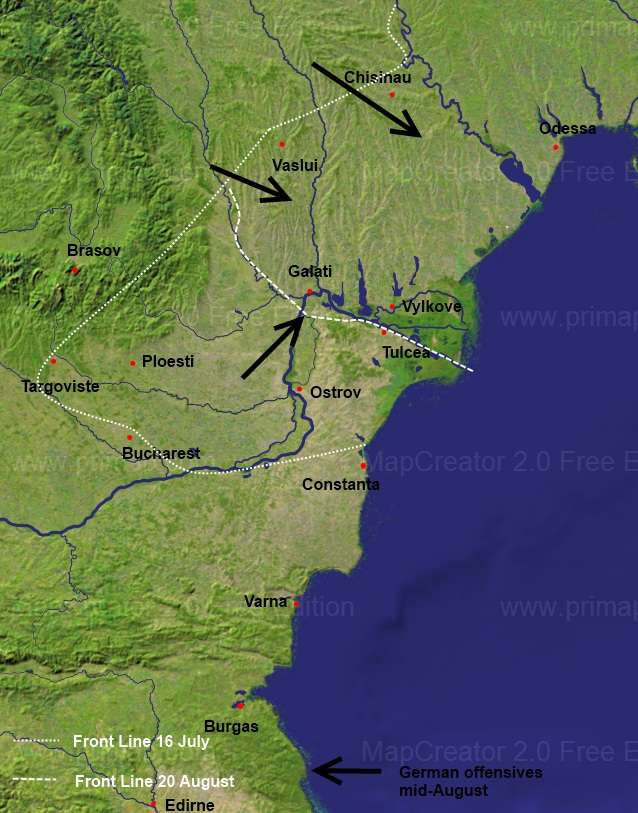
It was perhaps this ambivalence that doomed the first major incursion, in particular as the limited armour available to the South Ukrainian Front was allocated to 4 and 26 Army (as was 6 Cavalry Corps) leaving 9 Army with a single motorised rifle division and a brigade of KV-2s attached to the 19th Rifle Division.
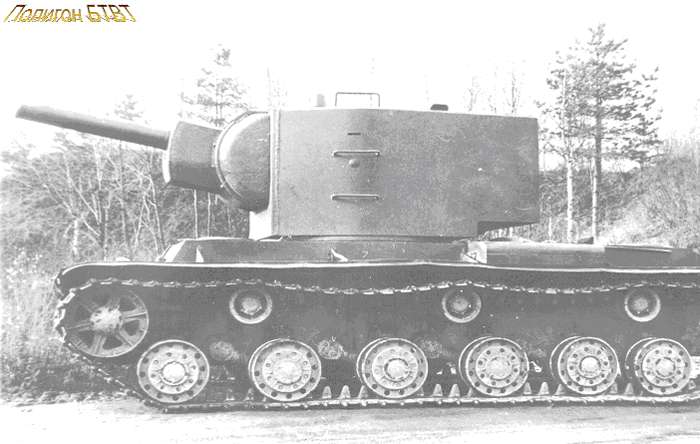
(KV-2 entering Rumania)
Once it was agreed to invade, Soviet Marines again seized Vylkove and this trapped retreating Rumanian units at Tulcea leading to almost 9000 prisoners being taken. Equally, to compensate for the lack of mobile forces, 76th Airborne division was dropped at Ploesti (where the Rumanian Government had fled when Bucharest had been seized in August 1941) in an attempt to speed the seizure of Bucharest.
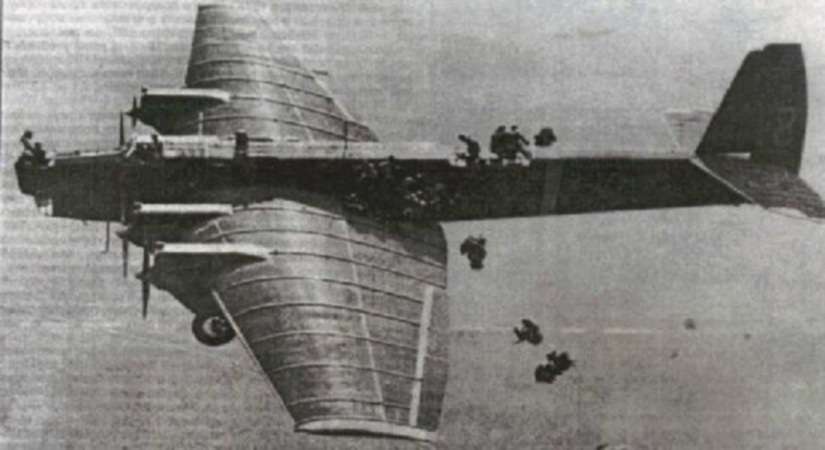
(Soviet paratroopers over Ploesti)
A planned naval invasion of Constanta was cancelled when it was realised the port was held by 4 German Paratroop divisions.
The initial weeks saw little coherent fighting as the Soviet and Axis forces raced for Bucharest. The initial attack on the city opened on 15 July and was halted on the 17th when a fresh German division arrived. The Soviet attack was renewed on the 19th but broken off on the 23rd in the face of both mounting axis resistance and a growing threat to their flanks.
It was clear that the forces in Rumania lacked both numbers and equipment. Two bloody attempts to clear Constanta ended in heavy losses
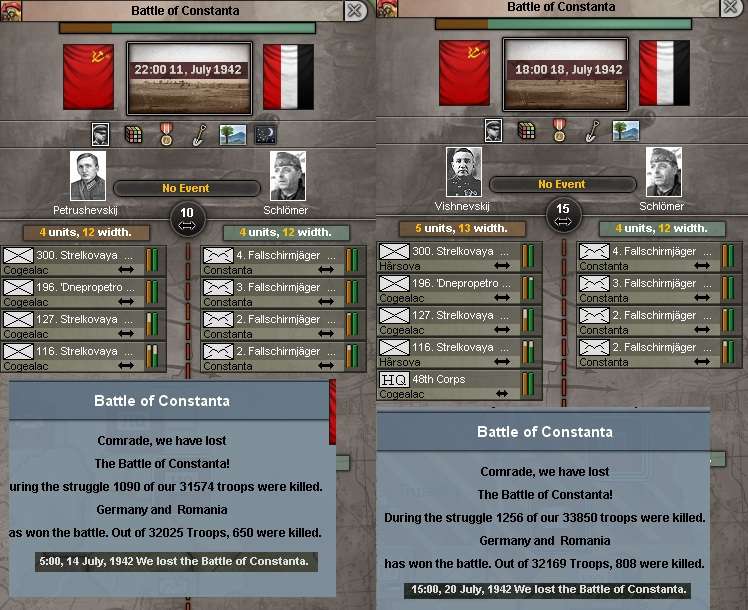
as did an attempt to sieze Targoviste and thus envelop Bucharest from the north.
At this juncture [2], 16 Panzer threatened 9 Army's communication lines when it broke through at Titu and 5 Heavy Armour retook Ploesti on 28 July.
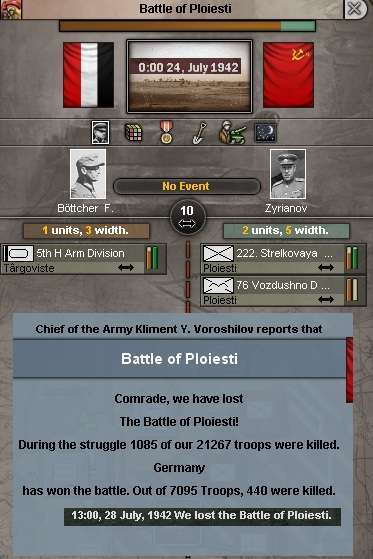
Rosetu was recaptured by the Germans on 3 August, again with heavy Soviet losses. Briefly, the attempt to pull 9 Army out of potential encirclement threatened to become a rout.
However, the heroic defense of Ostrov, covering the Danube crossings halted the German counterstroke, and inflicted heavy losses on 5 Heavy Armour and 16 Panzer.
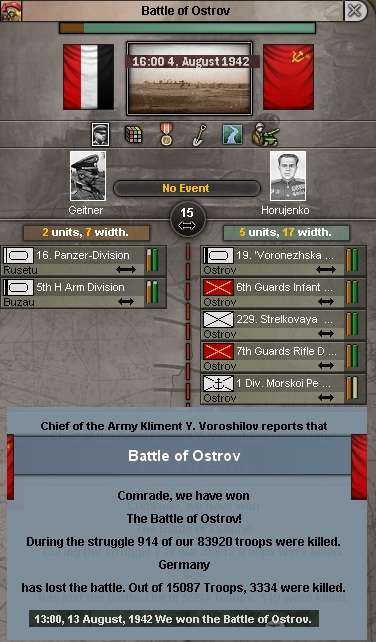
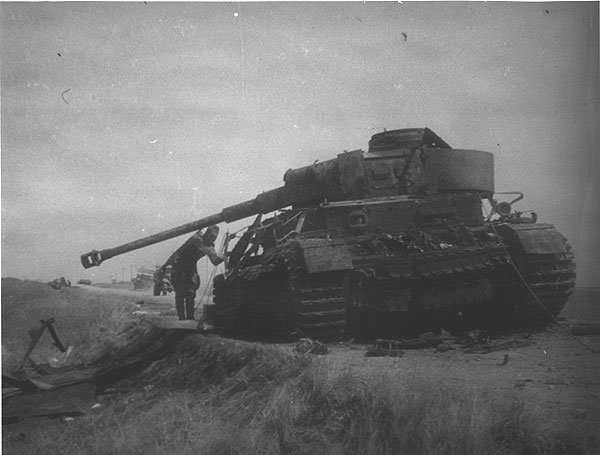
(German tank destroyed in one of the temporary bridgeheads the Germans established over the Danube)
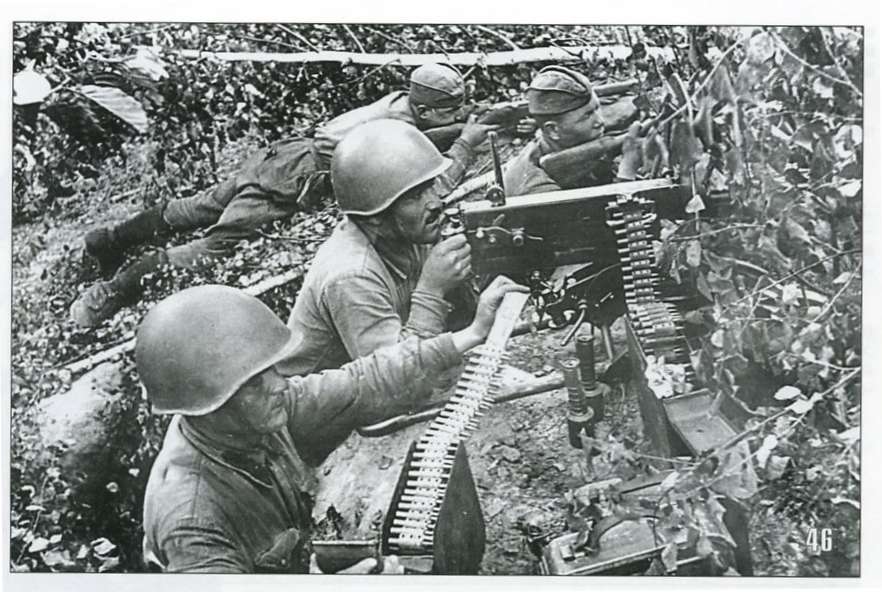
(Soviet defense lines at Ostrov)
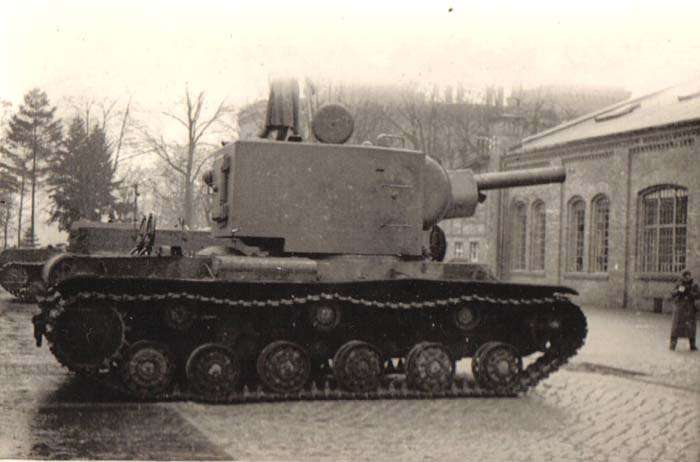
(KV-2 in reserve, Ostrov was one of the first times they were in direct opposition to the Tigers. Their generally poor performance led to a major redesign of Soviet heavy tanks and the introduction of the formidable IS-1 in early 1943)
These positions were then abandoned on 18 August, due to the German counterstroke in Bessarabia that again threatened encirclement. The defense allowed the bulk of 9 Army to escape, and the rearguard fell back steadily across the 1940 border.
The first major incursion outside the Soviet borders had failed but was probably better described as a raid in force, with the goal of knocking Rumania out of the war, than as a serious attempt to occupy the Balkans[3]. The lack of mobile forces had allowed the Germans to win the race for Bucharest, and then their willingness to commit 5 Panzer divisions (11, 16, 19 Panzer, 4, 5 Heavy Armour) had been more than enough not just to stop, but to hurl back 9 Army. Given all this, the relative losses reflected the growing confidence of Soviet rifle divisions in dealing with German armour. 12,323 Soviet soldiers died but killed 12,274 Germans in turn. In addition, the Rumanian army lost 9.028 prisoners and 3,007 dead. They also faced the indignity of their government having to flee again, and, yet again, to be rescued by the timely arrival of their allies.
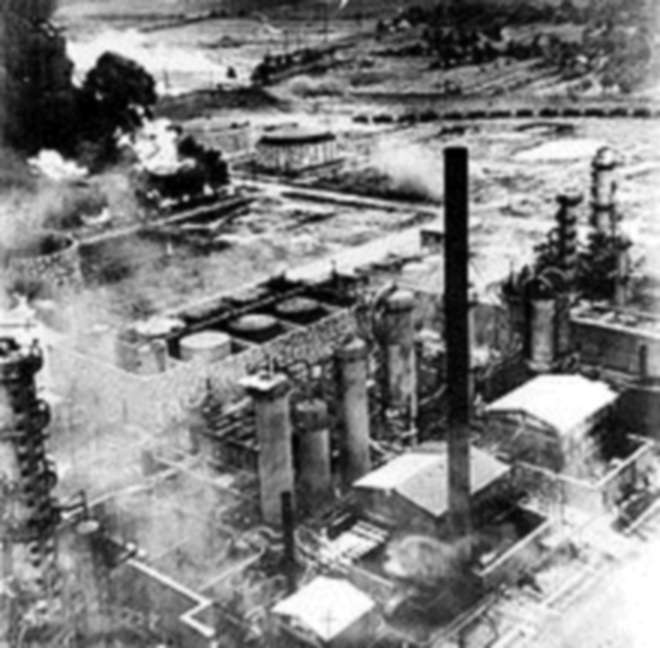
(Ploesti had been badly damaged in Soviet air-raids and then the subsequent fighting)
This sudden re-appearance of massed German armour was a warning as to what was to befall the Red Army across the Ukraine and Bielorussia. From somewhere, the Germans had found the means not just to re-organise their defences, they had the forces to return to the strategic offensive. Some were drawn from France, others were rebuilt from the shell of divisions badly handled in the Winter battles.
By late August, from the Black Sea to Lake Ladoga, the Red Army was to face a severe test.
[1] – actually even this wouldn't have happened, if Rumania had gone GIE then its remaining forces would have continued to fight for the Germans
[2] – I noticed a few times that the German AI would put a lot of effort into protecting its allies when they were threatened
[3] – a bit of a post event rationalisation to be honest
After the liberation of Odessa in late June, STAVKA was content to allow 4 Army to continue to attack into Bessarabia but the future role of 9 Army was subject to considerable debate.
One argument was it was best to stop the attack on the 1940 border and instead concentrate on securing Bessarabia with the option to envelop the German forces around Kiev. On the other hand, the potential existed to knock Rumania out of the war, removing 20-30 divisions in the process [1].

It was perhaps this ambivalence that doomed the first major incursion, in particular as the limited armour available to the South Ukrainian Front was allocated to 4 and 26 Army (as was 6 Cavalry Corps) leaving 9 Army with a single motorised rifle division and a brigade of KV-2s attached to the 19th Rifle Division.

(KV-2 entering Rumania)
Once it was agreed to invade, Soviet Marines again seized Vylkove and this trapped retreating Rumanian units at Tulcea leading to almost 9000 prisoners being taken. Equally, to compensate for the lack of mobile forces, 76th Airborne division was dropped at Ploesti (where the Rumanian Government had fled when Bucharest had been seized in August 1941) in an attempt to speed the seizure of Bucharest.

(Soviet paratroopers over Ploesti)
A planned naval invasion of Constanta was cancelled when it was realised the port was held by 4 German Paratroop divisions.
The initial weeks saw little coherent fighting as the Soviet and Axis forces raced for Bucharest. The initial attack on the city opened on 15 July and was halted on the 17th when a fresh German division arrived. The Soviet attack was renewed on the 19th but broken off on the 23rd in the face of both mounting axis resistance and a growing threat to their flanks.
It was clear that the forces in Rumania lacked both numbers and equipment. Two bloody attempts to clear Constanta ended in heavy losses

as did an attempt to sieze Targoviste and thus envelop Bucharest from the north.
At this juncture [2], 16 Panzer threatened 9 Army's communication lines when it broke through at Titu and 5 Heavy Armour retook Ploesti on 28 July.

Rosetu was recaptured by the Germans on 3 August, again with heavy Soviet losses. Briefly, the attempt to pull 9 Army out of potential encirclement threatened to become a rout.
However, the heroic defense of Ostrov, covering the Danube crossings halted the German counterstroke, and inflicted heavy losses on 5 Heavy Armour and 16 Panzer.


(German tank destroyed in one of the temporary bridgeheads the Germans established over the Danube)

(Soviet defense lines at Ostrov)

(KV-2 in reserve, Ostrov was one of the first times they were in direct opposition to the Tigers. Their generally poor performance led to a major redesign of Soviet heavy tanks and the introduction of the formidable IS-1 in early 1943)
These positions were then abandoned on 18 August, due to the German counterstroke in Bessarabia that again threatened encirclement. The defense allowed the bulk of 9 Army to escape, and the rearguard fell back steadily across the 1940 border.
The first major incursion outside the Soviet borders had failed but was probably better described as a raid in force, with the goal of knocking Rumania out of the war, than as a serious attempt to occupy the Balkans[3]. The lack of mobile forces had allowed the Germans to win the race for Bucharest, and then their willingness to commit 5 Panzer divisions (11, 16, 19 Panzer, 4, 5 Heavy Armour) had been more than enough not just to stop, but to hurl back 9 Army. Given all this, the relative losses reflected the growing confidence of Soviet rifle divisions in dealing with German armour. 12,323 Soviet soldiers died but killed 12,274 Germans in turn. In addition, the Rumanian army lost 9.028 prisoners and 3,007 dead. They also faced the indignity of their government having to flee again, and, yet again, to be rescued by the timely arrival of their allies.

(Ploesti had been badly damaged in Soviet air-raids and then the subsequent fighting)
This sudden re-appearance of massed German armour was a warning as to what was to befall the Red Army across the Ukraine and Bielorussia. From somewhere, the Germans had found the means not just to re-organise their defences, they had the forces to return to the strategic offensive. Some were drawn from France, others were rebuilt from the shell of divisions badly handled in the Winter battles.
By late August, from the Black Sea to Lake Ladoga, the Red Army was to face a severe test.
[1] – actually even this wouldn't have happened, if Rumania had gone GIE then its remaining forces would have continued to fight for the Germans
[2] – I noticed a few times that the German AI would put a lot of effort into protecting its allies when they were threatened
[3] – a bit of a post event rationalisation to be honest
[3] - Bit of a post event rationalization. - the update
Hehe. Well, obviously it was simply a raid. If it wasn't, it would imply Comrade Stalin did not plan to retreat.
Hehe. Well, obviously it was simply a raid. If it wasn't, it would imply Comrade Stalin did not plan to retreat.
Very good stuff. A pity the attack on Romania did not go a bit better, although casualties seem to have been equal, plus you took a large number of prisoners. As you stated towards the end, the arrival of so many Axis armoured units, seemingly out of the blue, has to be a cause for concern. Hopefully the Red Army is able to survive this 'severe test' well enough.
God, those KV-2s sure are ugly...
Well, that didn't go as you would've liked, but at least you managed to pull out your troops relatively unscathed. No units fell into encirclement, so that's good. I think BigBadBob has the best analysis: obviously, it was a raid in force. And what a raid! Surely this must count as the largest-scale raid in military history, yet more proof that the Red Army is Number One!
Good luck with the upcoming German counterstroke. If the casualty tally in Romania is anything to go by (where you were fighting on the offensive mostly), the Germans will pay a heavy price for any successes they have, which should pave the way nicely for your counter-counterstroke afterwards.
Well, that didn't go as you would've liked, but at least you managed to pull out your troops relatively unscathed. No units fell into encirclement, so that's good. I think BigBadBob has the best analysis: obviously, it was a raid in force. And what a raid! Surely this must count as the largest-scale raid in military history, yet more proof that the Red Army is Number One!
Good luck with the upcoming German counterstroke. If the casualty tally in Romania is anything to go by (where you were fighting on the offensive mostly), the Germans will pay a heavy price for any successes they have, which should pave the way nicely for your counter-counterstroke afterwards.
I have a feeling that the Axis would reoccupy the smoking remains of the Ploiesti refinery complex rather than anything of actual use. According to Wiki, the area accounted for 35% of all the Axis's oil supplies. I think that a successful Soviet raid and systematic destruction of infrastructure would put a big dent in the Axis's war-fighting capabilities.
As to whether the operation was a raid, you yourself have admitted the general staff were basically winging it at this point. You hurt the Germans, and you're just about back to the pre-war borders, so all in all a resounding success. It remains to be seen if you can hold on to these gains.
As to whether the operation was a raid, you yourself have admitted the general staff were basically winging it at this point. You hurt the Germans, and you're just about back to the pre-war borders, so all in all a resounding success. It remains to be seen if you can hold on to these gains.
Nearly victorious!
Fighting in Archangels and in Romania at the same time.
Time to shorten the front?
How many forces do the Germans have outside the eastern front?
Weak enough to be hit by allies? Or allied AI sitting and watching, plotting revenge?
Fighting in Archangels and in Romania at the same time.
Time to shorten the front?
How many forces do the Germans have outside the eastern front?
Weak enough to be hit by allies? Or allied AI sitting and watching, plotting revenge?

